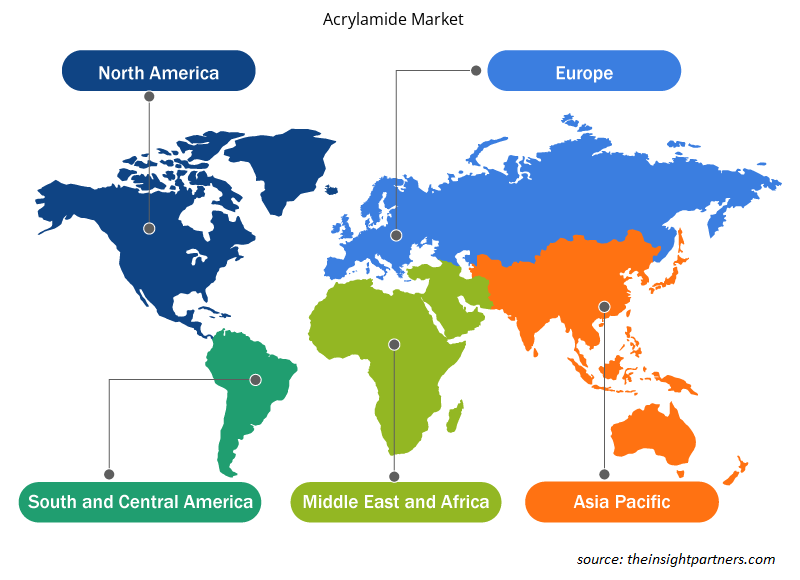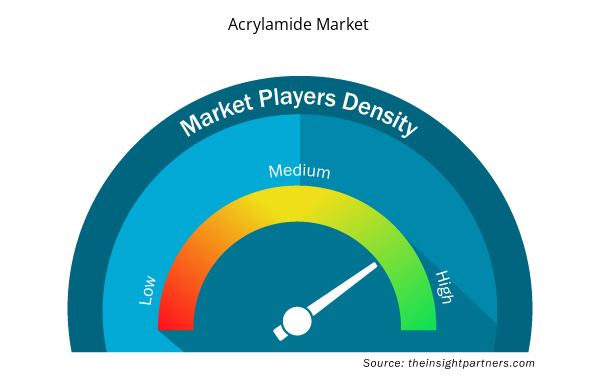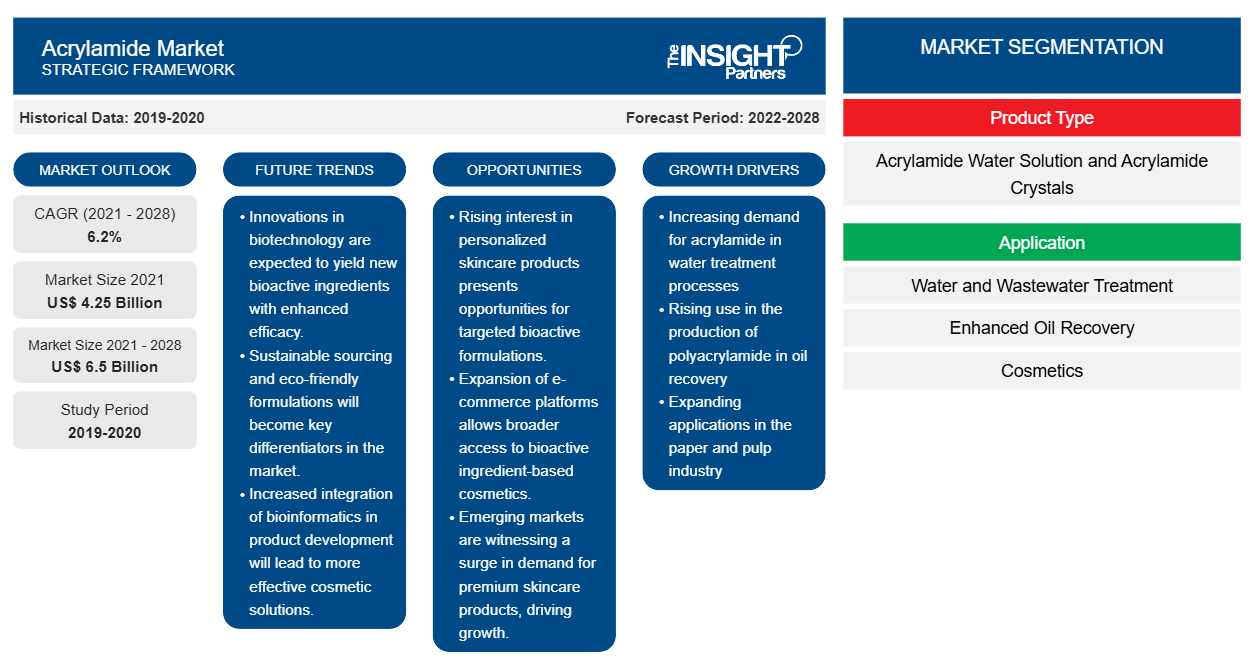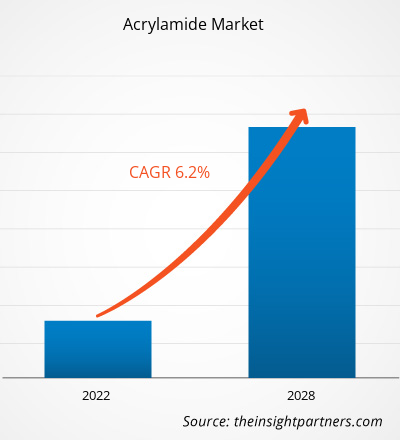アクリルアミド市場は、2021年の42億5,416万米ドルから2028年には65億22万米ドルに成長すると予想されており、2021年から2028年にかけて6.2%のCAGRで成長すると予測されています。
アクリルアミドは、液体および結晶の形で入手できる無臭の有機化学物質です。アクリルアミドは水およびさまざまな有機溶媒に溶けます。アクリルアミドは、水溶性増粘剤や凝集剤としてさまざまな用途に使用されているポリアクリルアミドの前駆体です。
2020年、アジア太平洋地域は世界のアクリルアミド市場を支配し、予測期間中もその優位性を維持すると予想されています。日本と中国はアクリルアミドの主要製造国であり、世界の設置容量のかなりの部分を占めています。インドや中国などの国での廃水処理に対する政府の支援の増加と、この地域でのパーソナルケアおよび化粧品産業の成長が、アジア太平洋地域の市場の成長を牽引しています。この地域のパーソナルケア産業は、中間所得層の増加、一人当たりの所得の増加、生活水準の向上、働く女性人口の増加により成長しています。したがって、パーソナルケア産業の成長は、化粧品およびパーソナルケア製品の安定剤、結合剤、増粘剤として広く使用されているアクリルアミドの需要の増加につながっています。これに伴い、北米は廃水処理への投資の増加と、強化油回収および化粧品部門からのアクリルアミドの需要の増加により、2番目に急成長している地域になると予想されています。ヨーロッパも予測期間中に大幅な成長が見込まれています。
要件に合わせてレポートをカスタマイズする
このレポートの一部、国レベルの分析、Excelデータパックなど、あらゆるレポートを無料でカスタマイズできます。また、スタートアップや大学向けのお得なオファーや割引もご利用いただけます。
- このレポートの主要な市場動向を入手してください。この無料サンプルには、市場動向から見積もりや予測に至るまでのデータ分析が含まれます。
市場分析
廃水処理の需要増加
世界中で経済の力強い成長、人口増加、急速な都市化が進み、飲料水の消費量と廃水の発生量が増加しています。さまざまな国が水域の汚染や廃水の違法排出に対して厳しい規制を施行しています。大気汚染の影響を受ける中国などの国では、廃水排出の有害な影響から国を守るために特別な法律が施行されています。産業排水には健康被害をもたらし、海洋生物の多様性を妨げる可能性のある有害な化学物質が含まれているため、産業廃水管理は規制機関にとって重要な懸念事項となっています。したがって、世界中で廃水処理の需要が増加し、市場の成長を牽引しています。
製品タイプの洞察
製品タイプに基づいて、市場はアクリルアミド水溶液とアクリルアミド結晶に分かれています。2020年、アクリルアミド結晶セグメントはアクリルアミド市場で最も急速に成長したセグメントでした。アクリルアミド結晶にはさまざまな用途があり、凝集剤、ブロッキング剤、繊維処理剤、水処理剤として使用されています。
Ashland Global Holding Inc.、SNF、Kemira OYJ、BASF SE、EMCO Dyestuff、Mitsui Chemicals Global、Pvt. Ltd.、Ineos AG、Solvay、Nuoer Group、Black Rose Industries Ltd. は、世界市場で活動する主要企業です。主要企業は、合併や買収、製品の発売など、さまざまな戦略を採用して、地理的プレゼンスと顧客基盤を拡大しています。
アクリルアミド市場の地域別分析
予測期間を通じてアクリルアミド市場に影響を与える地域的な傾向と要因は、Insight Partners のアナリストによって徹底的に説明されています。このセクションでは、北米、ヨーロッパ、アジア太平洋、中東、アフリカ、南米、中米にわたるアクリルアミド市場のセグメントと地理についても説明します。

- アクリルアミド市場の地域別データを入手
アクリルアミド市場レポートの範囲
| レポート属性 | 詳細 |
|---|---|
| 2021年の市場規模 | 42.5億米ドル |
| 2028年までの市場規模 | 65億米ドル |
| 世界のCAGR(2021年~2028年) | 6.2% |
| 履歴データ | 2019-2020 |
| 予測期間 | 2022-2028 |
| 対象セグメント | 製品タイプ別
|
| 対象地域と国 | 北米
|
| 市場リーダーと主要企業プロフィール |
|
アクリルアミド市場のプレーヤー密度:ビジネスダイナミクスへの影響を理解する
アクリルアミド市場は、消費者の嗜好の変化、技術の進歩、製品の利点に対する認識の高まりなどの要因により、エンドユーザーの需要が高まり、急速に成長しています。需要が高まるにつれて、企業は提供を拡大し、消費者のニーズを満たすために革新し、新たなトレンドを活用し、市場の成長をさらに促進しています。
市場プレーヤー密度とは、特定の市場または業界内で活動している企業または会社の分布を指します。これは、特定の市場スペースに、その規模または総市場価値と比較して、どれだけの競合相手 (市場プレーヤー) が存在するかを示します。
アクリルアミド市場で事業を展開している主要企業は次のとおりです。
- INEOS スタイロリューション インド リミテッド
- アッシュランド・グローバル・ホールディングス株式会社
- SNF
- ケミラ株式会社
- BASF SE
免責事項:上記の企業は、特定の順序でランク付けされていません。

- アクリルアミド市場のトップキープレーヤーの概要を入手
レポートの注目点
- アクリルアミド業界の進歩的なトレンドは、プレーヤーが効果的な長期戦略を策定するのに役立ちます
- 先進国市場と発展途上国市場での成長を確保するために企業が採用する事業成長戦略
- 2019年から2028年までの世界のアクリルアミド市場の定量分析
- さまざまな業界におけるアクリルアミドの需要の推定
- ポーター分析は、業界で活動するバイヤーとサプライヤーの有効性を示し、市場の成長を予測します。
- 競争市場シナリオとアクリルアミドの需要を理解するための最近の動向
- アクリルアミド市場の成長を牽引および抑制する要因と相まって、市場の動向と見通し
- 世界的なアクリルアミド市場の成長に関する商業的関心を支える戦略についての理解は、意思決定プロセスに役立ちます。
- 市場のさまざまなノードにおけるアクリルアミドの市場規模
- 世界のアクリルアミド市場の詳細な概要とセグメンテーション、およびその業界動向
- 有望な成長機会のあるさまざまな地域のアクリルアミド市場規模
「2028年までの世界のアクリルアミド市場分析」は、世界のアクリルアミド市場のトレンド分析に焦点を当てた、化学および材料業界の専門的かつ詳細な調査です。このレポートは、詳細な市場セグメンテーションで市場の概要を提供することを目的としています。アクリルアミド市場は、製品タイプ、用途、および地域に基づいてセグメント化されています。製品タイプに基づいて、市場はアクリルアミド水溶液とアクリルアミド結晶に分かれています。用途に基づいて、市場は水および廃水処理、石油回収強化、化粧品、製紙、化学中間体、繊維、その他に分割されています。地域に基づいて、市場は北米、ヨーロッパ、アジア太平洋、中東およびアフリカ、南米および中米の5つの主要地域に分割されています。アクリルアミドは、廃水処理の凝集剤として使用されるアクリルアミドポリマー(ポリアクリルアミド)の製造に使用されます。これは、ろ過によって除去できる有機物を凝固させます。世界中で廃水処理施設の開発が進むにつれ、アクリルアミドの需要が増加しています。
企業プロフィール
- アッシュランド・グローバル・ホールディングス
- SNF
- ケミラOYJ
- BASF SE
- EMCO染料
- 三井化学グローバル株式会社
- イネオスAG
- ソルベイ
- ヌオエルグループ
- ブラックローズインダストリーズ株式会社;
- 過去2年間の分析、基準年、CAGRによる予測(7年間)
- PEST分析とSWOT分析
- 市場規模価値/数量 - 世界、地域、国
- 業界と競争環境
- Excel データセット


- Explosion-Proof Equipment Market
- Third Party Logistics Market
- Molecular Diagnostics Market
- Procedure Trays Market
- Authentication and Brand Protection Market
- Advanced Planning and Scheduling Software Market
- Small Molecule Drug Discovery Market
- Identity Verification Market
- High Speed Cable Market
- Organoids Market

Report Coverage
Revenue forecast, Company Analysis, Industry landscape, Growth factors, and Trends

Segment Covered
This text is related
to segments covered.

Regional Scope
North America, Europe, Asia Pacific, Middle East & Africa, South & Central America

Country Scope
This text is related
to country scope.
よくある質問
The global acrylamide market is primarily driven rising demand for wastewater treatment and rapid growth of the chemicals and materials industry globally.
Based on application, the water and wastewater treatment segment held the largest share in the global acrylamide market. Acrylamide is used to manufacture acrylamide polymer (polyacrylamide) which is used as a flocculent in wastewater treatment.
Based on product type, the acrylamide crystals segment held the largest share in the acrylamide market. It is a precursor to polyacrylamides that have a wide range of applications as water-soluble thickeners and flocculation agents.
In 2020, Asia-Pacific led the global acrylamide market. The increasing focus on municipal and industrial wastewater treatment is driving the demand for acrylamide in the region. Moreover, the governments are also investing in sewage treatment plants to promote the reuse and recycling of water.
Acrylamide is used to manufacture acrylamide polymer (polyacrylamide) which is used as a flocculent in wastewater treatment. It coagulates the organic matter which can be removed by filtration.
Some of the prominent players operating in the global acrylamide market include INEOS, Ashland Global Holdings Inc., SNF, Kemira Oyj, BASF SE, Black Rose Industries Ltd, Mitsui Chemicals India Pvt. Ltd., Solvay S.A., NUOER GROUP and EMCO Dyestuff, among others.
Trends and growth analysis reports related to Chemicals and Materials : READ MORE..
The List of Companies - Acrylamide Market
- INEOS Styrolution India Limited
- Ashland Global Holdings Inc.
- SNF
- Kemira Oyj
- BASF SE
- Black Rose Industries Ltd
- Mitsui Chemicals India Pvt. Ltd.
- Solvay S.A.
- NUOER GROUP
- EMCO Dyestuff
The Insight Partners performs research in 4 major stages: Data Collection & Secondary Research, Primary Research, Data Analysis and Data Triangulation & Final Review.
- Data Collection and Secondary Research:
As a market research and consulting firm operating from a decade, we have published and advised several client across the globe. First step for any study will start with an assessment of currently available data and insights from existing reports. Further, historical and current market information is collected from Investor Presentations, Annual Reports, SEC Filings, etc., and other information related to company’s performance and market positioning are gathered from Paid Databases (Factiva, Hoovers, and Reuters) and various other publications available in public domain.
Several associations trade associates, technical forums, institutes, societies and organization are accessed to gain technical as well as market related insights through their publications such as research papers, blogs and press releases related to the studies are referred to get cues about the market. Further, white papers, journals, magazines, and other news articles published in last 3 years are scrutinized and analyzed to understand the current market trends.
- Primary Research:
The primarily interview analysis comprise of data obtained from industry participants interview and answers to survey questions gathered by in-house primary team.
For primary research, interviews are conducted with industry experts/CEOs/Marketing Managers/VPs/Subject Matter Experts from both demand and supply side to get a 360-degree view of the market. The primary team conducts several interviews based on the complexity of the markets to understand the various market trends and dynamics which makes research more credible and precise.
A typical research interview fulfils the following functions:
- Provides first-hand information on the market size, market trends, growth trends, competitive landscape, and outlook
- Validates and strengthens in-house secondary research findings
- Develops the analysis team’s expertise and market understanding
Primary research involves email interactions and telephone interviews for each market, category, segment, and sub-segment across geographies. The participants who typically take part in such a process include, but are not limited to:
- Industry participants: VPs, business development managers, market intelligence managers and national sales managers
- Outside experts: Valuation experts, research analysts and key opinion leaders specializing in the electronics and semiconductor industry.
Below is the breakup of our primary respondents by company, designation, and region:

Once we receive the confirmation from primary research sources or primary respondents, we finalize the base year market estimation and forecast the data as per the macroeconomic and microeconomic factors assessed during data collection.
- Data Analysis:
Once data is validated through both secondary as well as primary respondents, we finalize the market estimations by hypothesis formulation and factor analysis at regional and country level.
- Macro-Economic Factor Analysis:
We analyse macroeconomic indicators such the gross domestic product (GDP), increase in the demand for goods and services across industries, technological advancement, regional economic growth, governmental policies, the influence of COVID-19, PEST analysis, and other aspects. This analysis aids in setting benchmarks for various nations/regions and approximating market splits. Additionally, the general trend of the aforementioned components aid in determining the market's development possibilities.
- Country Level Data:
Various factors that are especially aligned to the country are taken into account to determine the market size for a certain area and country, including the presence of vendors, such as headquarters and offices, the country's GDP, demand patterns, and industry growth. To comprehend the market dynamics for the nation, a number of growth variables, inhibitors, application areas, and current market trends are researched. The aforementioned elements aid in determining the country's overall market's growth potential.
- Company Profile:
The “Table of Contents” is formulated by listing and analyzing more than 25 - 30 companies operating in the market ecosystem across geographies. However, we profile only 10 companies as a standard practice in our syndicate reports. These 10 companies comprise leading, emerging, and regional players. Nonetheless, our analysis is not restricted to the 10 listed companies, we also analyze other companies present in the market to develop a holistic view and understand the prevailing trends. The “Company Profiles” section in the report covers key facts, business description, products & services, financial information, SWOT analysis, and key developments. The financial information presented is extracted from the annual reports and official documents of the publicly listed companies. Upon collecting the information for the sections of respective companies, we verify them via various primary sources and then compile the data in respective company profiles. The company level information helps us in deriving the base number as well as in forecasting the market size.
- Developing Base Number:
Aggregation of sales statistics (2020-2022) and macro-economic factor, and other secondary and primary research insights are utilized to arrive at base number and related market shares for 2022. The data gaps are identified in this step and relevant market data is analyzed, collected from paid primary interviews or databases. On finalizing the base year market size, forecasts are developed on the basis of macro-economic, industry and market growth factors and company level analysis.
- Data Triangulation and Final Review:
The market findings and base year market size calculations are validated from supply as well as demand side. Demand side validations are based on macro-economic factor analysis and benchmarks for respective regions and countries. In case of supply side validations, revenues of major companies are estimated (in case not available) based on industry benchmark, approximate number of employees, product portfolio, and primary interviews revenues are gathered. Further revenue from target product/service segment is assessed to avoid overshooting of market statistics. In case of heavy deviations between supply and demand side values, all thes steps are repeated to achieve synchronization.
We follow an iterative model, wherein we share our research findings with Subject Matter Experts (SME’s) and Key Opinion Leaders (KOLs) until consensus view of the market is not formulated – this model negates any drastic deviation in the opinions of experts. Only validated and universally acceptable research findings are quoted in our reports.
We have important check points that we use to validate our research findings – which we call – data triangulation, where we validate the information, we generate from secondary sources with primary interviews and then we re-validate with our internal data bases and Subject matter experts. This comprehensive model enables us to deliver high quality, reliable data in shortest possible time.


 このレポートの無料サンプルを入手する
このレポートの無料サンプルを入手する